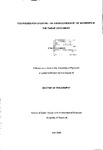TECHNIQUES FOR STUDYING THE BIOGEOCHEMISTRY OF NUTRIENTS IN THE TAMAR CATCHMENT
| dc.contributor.author | MANKASINGH, UTRA | |
| dc.contributor.other | Faculty of Science and Engineering | en_US |
| dc.date.accessioned | 2013-10-11T11:55:03Z | |
| dc.date.available | 2013-10-11T11:55:03Z | |
| dc.date.issued | 2005 | |
| dc.identifier | NOT AVAILABLE | en_US |
| dc.identifier.uri | http://hdl.handle.net/10026.1/2184 | |
| dc.description.abstract |
Chapter One describes nitrogen and phosphorus species in the aquatic environment, their role in eutrophication, current legislation relevant to nutrient water quality and catchment management and the role of predictive modelling of nutrient export with respect to the management of river catchments. It also summarises analytical techniques for the determination of nitrogen and phosphorus species in natural waters and the use of generic ecotoxicological assays to link nutrient water quality and organism health. Data integrity is essential to biogeochemical studies that inform scientific research and environmental management. Reliable, accurate data permit valid conclusions to be drawn. The quality assurance and quality control measures undertaken to ensure good analytical data in this study, including participation in the certification of a seawater certified reference material for nutrients (MOOS-1), are discussed in Chapter Two. In Chapter Three, the nutrient biogeochemistry of the waters leaving the Tamar catchment and entering the Tamar estuary is discussed. Historical nutrient and physico-chemical data for the Tamar River at Gunnislake were used to identify long-term environmental trends (1974 to 2004) and nutrient and physico-chemical data collected in this study between May 2003 and May 2004 was used to identify short-term trends over the study period. The nutrient export coefficient modelling approach was used to model phosphorus and nitrogen export from the Tamar catchment (Chapter Four). A TP export model from the Tamar catchment was successfully constructed using historical land use data and catchment demographics, calibrated with hindcasted water quality data, and validated with TP field data (May 2003 and May 2004) collected in this study. Modelled P (43. 5 tonnes P yˉ¹) export agreed within 8 % with the measured P load (40.1 tonnes P yˉ¹). An annual TN model was also constructed and calibrated for the Tamar catchment using the May 2003 to May 2004 field data. The calibrated model agreed within I % of the measured TN export (2053 tonnes N yˉ¹). The development and deployment of a portable Fl analyser for continuous, real-time monitoring of FRP in the Tamar catchment is discussed in Chapter Five. The optimised method can be used for the determination of FRP in freshwater systems (4-150 µg Lˉ¹ P) and in coastal waters (10-150 µg Lˉ¹ P) and is capable of sampling with high temporal resolution (up to 15 samples hˉ¹) . The analyser was used in situ (bank-side and shipboard deployment) to provide real-time FRP data and in the laboratory to determine FRP in freshwater samples. All data were in good agreement with values obtained using a validated air-segmented, continuous flow laboratory reference method The acute toxicity of nitrate and nitrite on the freshwater swan mussel, Anodonta cygnea, was investigated (Chapter Six). A 96 h LC50 value of 222 mg Lˉ¹ N for the exposure of A. cygnea to nitrite was established in this study. Toxicity studies indicated that nitrate was not toxic to A. cygnea. Established indicators of physiological stress were used to determine the effect of environmentally high and extreme levels of nitrite on A. cygnea. There was no significant difference in cardiac activity, condition index or lysosomal stability between control organisms (0 mg Lˉ¹ N) and organisms exposed to sub-lethal nitrite concentrations (0.1, 1.0, 22.2 mg Lˉ¹ N). Therefore, nitrite concentrations encountered in typical freshwater catchments such as the Tamar catchment are unlikely to induce physiological stress in A.cygnea. | en_US |
| dc.language.iso | en | en_US |
| dc.publisher | University of Plymouth | en_US |
| dc.title | TECHNIQUES FOR STUDYING THE BIOGEOCHEMISTRY OF NUTRIENTS IN THE TAMAR CATCHMENT | en_US |
| dc.type | Thesis | |
| dc.identifier.doi | http://dx.doi.org/10.24382/4636 |
Files in this item
This item appears in the following Collection(s)
-
01 Research Theses Main Collection
Research Theses Main


